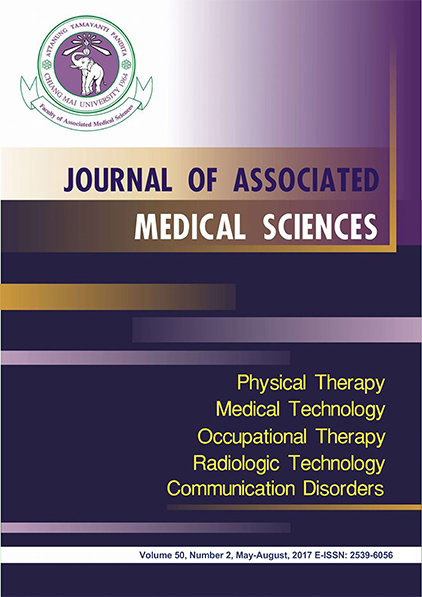Test-retest reliability of balance assessment using Swaymeter in children with Down syndrome aged 7-12 years
Main Article Content
Abstract
Background: Balance assessment in children with balance impairment especially in children with Down syndrome is an important element in physical therapy evaluation. Usual clinical balance assessment is limited because it can’t measure of body sway in any direction. Swaymeter is an equipment that can detect postural sway mainly in antero-posterior and medio-lateral directions. It is compact and lightweight. It requires a short administration and data processing time in measuring. However, there is no report supporting reliability of Swaymeter equipment for balance assessment in children with Down syndrome.
Objectives: To examine the test-retest reliability of postural sway measures obtained from Swaymeter in children with Down syndrome aged 7-12 years.
Materials and methods: There were 25 subjects participated in the study. Assessments of sway area were performed totally of 4 conditions: floor with eyes open and eyes closed, foam with eyes open and eyes closed. The assessment of postural sway was measure for three times in the same day and a week later.
Results: Reliability (ICC3,1) of the sway area in condition 1: floor with eyes open is good (ICC=0.75-0.82); condition 2: floor with eyes closed is moderate (ICC=0.66- 0.69); condition 3: foam with eyes open is low to moderate (ICC=0.57-0.71) and condition 4: foam with eyes closed is low (ICC=0.45-0.49). Sandard error of measurement (SEM) was ranged from 0.26- 0.38.mm
Conclusion: It was suggested that postural sway measured by Swaymeter is reliable in condition floor with eyes open and eyes closed. Swaymeter is suitable for applying in clinic and research for assessment of balance in children with Down syndrome aged 7-12 years.
Journal of Associated Medical Sciences 2017; 50(2): 253-261. Doi: 10.14456/jams.2017.25
Article Details

This work is licensed under a Creative Commons Attribution-NonCommercial-NoDerivatives 4.0 International License.
Personal views expressed by the contributors in their articles are not necessarily those of the Journal of Associated Medical Sciences, Faculty of Associated Medical Sciences, Chiang Mai University.
References
2. Scott BS, Becker LE, Petit TL. Neurobiology of Down’s syndrome. Prog Neurobiol.1983; 21: 199-237. doi: 10.1016/0301-0082(83)90002-3.
3. Galli M, Rigoldi C, Mainardi L, Tenore N, OnoratiP, Albertini G. Postural control in patients with Down syndrome. Disabil Rehabil 2008; 30: 1274-8. doi: 10.1080/09638280701610353.
4. Shumway-Cook A, Woollacott MH. Dynamics of postural control in the child with Down syndrome. Phys Ther 1985; 65(9): 1315-22.
5. Aruin AS, Almeida GL, Latash ML. Organization of a simple two-joint synergy in individuals with Down syndrome. Am J Ment Retard 1996; 101(3): 256-68.
6. Rigoldi C, Galli M, Mainardi L, Crivellini M, Albertini G. Postural control in children, teenagers and adults with Down syndrome. Res Dev Disabil 2011; 32: 170-5. doi: 10.1016/j.ridd.2010.09.007.
7. Mancini M, Horak FB. The relevance of clinical balance assessment tools to differentiate balance deficit. Eur J Phys Rehabil Med 2010; 46(2): 239-48.
8. Biec E, Zima J, Wojtowicz D, Wojciechowska-Maszkowska B, Krecisz K, Kuczynski M. Postural stability in young adults with Down syndrome in challenging conditions. PLoS One 2014; 9(4): e94247. doi:10.1371/journal.pone.0094247.
9. Lord SR, Clark RD. Simple physiological and clinical tests for the accurate prediction of falling in older people. Gerontology 1996; (4): 199-203. doi: 10.1159/000213793.
10. Lord SR, Ward JA, Williams P, Anstey KJ. Physiological factors associated with falls in older community-dwelling women. J Am Geriatr Soc 1994; 42(10): 1110-7. doi: 10.1111/j.1532-5415.1994.tb06218.x.
11. Sturnieks DL, Arnold R, Lord SR. Validity and reliability of the Swaymeter device for measuring postural sway. BMC Geriatr 2011; 11: 63. doi: 10.1186/1471-2318-11-63.
12. Rajendran V, Roy FG, Jeevanantham D. A preliminary randomized controlled study on the effectiveness of vestibular-specific neuromuscular training in children with hearing impairment. Clinical Rehab 2013; 27: 459-67. doi: 10.1177/0269215512462909.
13. Domholdt E. Physical therapy research: principles and applications. 2nd ed. Philadelphia: WB Saunders; 2000.
14. Lin D, Seol H, Nussbaum MA, Madigan ML. Reliability of COP-based postural sway measures and age-related differences. Gait Posture 2008; 28(2): 337-42. doi: 10.1016/j.gaitpost.2008.01.005.
15. Shumway-Cook A, Woollacott MH. Dynamics of postural control in the child with Down syndrome. Phys Ther 1985; 65(9): 1315-22.
16. Baloh RW, Fife TD, Zwerling L, Socotch T, Jacobson K, Bell T, et al. Comparison of static and dynamic posturography in young and older normal people. J Am Geriatr Soc 1994; 42: 405-12. DOI: 10.1111/j.1532-5415.1994.tb07489.x.
17. Tahmasebi R, Karimi MT, Satvati B, Fatoye F. Evaluation of standing stability in individuals with flatfeet. Foot Ankle Spec 2015; 8(3): 168-74. doi: 10.1177/1938640014557075.
18. Horak FB. Postural orientation and equilibrium: what do we need to know about neural control of balance to prevent falls? Age Ageing 2006; 35 Suppl2: ii7-ii11. doi:10.1093/ageing/afl077.


